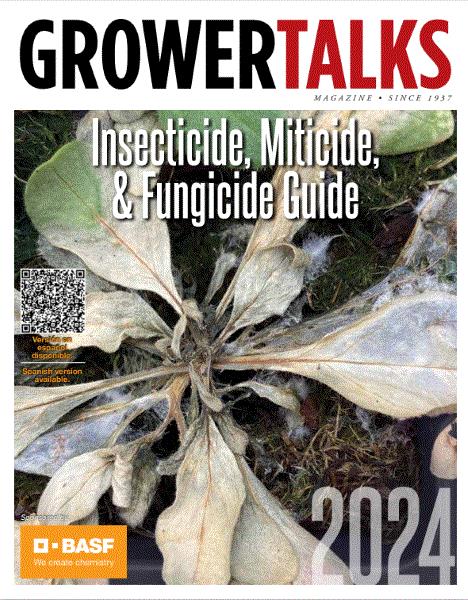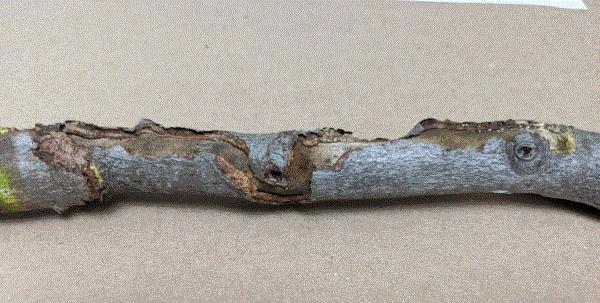The 2024 IMF Guide is Out!

IMF? No, not the International Monetary Fund! I must have spent too much time on all the economic podcasts ...
It's GrowerTalks’ annual Insecticide, Miticide & Fungicide Guide! You can now access the 2024 IMF Guide for free and online! Available in both English and Spanish, this edition is once again sponsored by BASF.
I saved a copy of the IMF Guide on my desktop as a quick reference for insecticides and fungicides registered for different pests and diseases. In addition to the fungicide, insecticide and miticide lists, I also enjoy reading the articles included in each version. The new guide features the efforts at North Creek Nurseries to integrate native plants, data, sustainable pest management, community and education in their operation. I’ve purchased plants from North Creek Nurseries, but I didn’t know so much went into the mountain mint plugs that I received!
Ann Chase talked about diseases caused by Xanthomonas. As Ann mentioned, not all Xanthomonas are pathogens, but the pathogenic ones can cause serious diseases, such as bacterial leaf spot. Ann also provided a table of effective bactericides against Xanthomonas.
I contributed an article on managing mites. I talked about cultural, biological and chemical management of mites. Y’all may find two tables—one on available biological control agents and the other on miticides—to be very useful.
Danny Lauderdale of North Carolina State University contributed an article on managing redheaded flea beetle. This is a beast which we don’t have an effective management approach for yet. Danny has worked on the redheaded flea beetle for years; I would consider Danny as the person with the most up-to-date experimentally derived information on this pest. In the article, Danny tied together biology of the beetle and available management tools, which likely will result in more effective management.
Go HERE for the English version of the IMF Guide and HERE for the Spanish version.

Corteva Introducing Floxcor Fungicide
Corteva Agriscience announced that a new fungicide, called Floxcor, will be available to the turf and ornamental market in late 2023. Floxcor contains fluoxastrobin, a FRAC Group 11 (strobilurin) fungicide with a broad spectrum of activities against 28 foliar, stem and root diseases. You may know fluoxastrobin, which is also the active ingredient in Disarm and Fame.
Fluoxastrobin is a systemic fungicide that moves quickly into the plant tissues through absorption. Target diseases include anthracnose, brown patch, fairy ring, leaf spot, pythium and snow mold on turfgrasses and ornamental plants in greenhouses, nurseries, landscapes, golf courses and lawns. Application becomes rainfast in 15 minutes.
I’ll chat more about this product once it’s available for purchase in the marketplace and a label is ready for review.
IR-4 Updated Liverwort Efficacy Summary
The IR-4 Environmental Horticulture Project updated its liverwort efficacy summary last week. I’m hearing more about difficulties in controlling liverwort and nostoc during my travels and visits with growers. Liverwort is particularly difficult to manage in containerized plants because of poor efficacy and high risk of damage from currently available products.
Liverwort is an interesting weed. Because of its creeping growth habit and flattened “leaves,” many growers think liverwort is a moss. I can see where the confusion comes from. Just like moss, liverwort is a non-vascular plant, loves to grow in a cool, low-light environment and on moist soil or media. Both moss and liverwort propagates through what’s called a gametophyte-dominant life cycle. Pretty interesting stuff.
Go HERE for an article on liverwort from Debaline Saha and Heidi Lindberg of Michigan State University.

Liverwort in containerized plants. (Photo credit: Debaline Saha, Michigan State University.)
What’s undeniable is liverwort’s impact on containerized plant production, particularly those with a longer production cycle. Liverwort competes with plants for water, nutrients and growing space. It's rather ugly to look at to boot. Management using herbicide may be tricky because you may have to worry about the herbicide getting in contact with and damaging plants.
What does IR-4 say about the efficacy of herbicides against liverwort? Obviously, the number of herbicides suitable for this type of application will be low because most herbicides can damage crops. Despite the limitations, IR-4 managed to conduct 302 research trials on 37 products (29 active ingredients). Most of these products were applied as post-emergent.
Among the tested products, AvengerAg (d-limonene; unclassified by WSSA), baking soda (unclassified), Byrophyter (oregano oil; unclassified), Racer (ammonium nonanoate; unclassified), Scythe (pelargonic acid; 17), SureGuard (flumioxazin; 14), and WeedPharm (acetic acid; unclassified) stand out as the most effective post-emergent options, and Tower (dimethenamid-p; 15) as the most effective pre-emergent option.
Do y’all notice that most of these effective herbicides work by contact? So be careful with application so you don’t damage the crops, especially those with green, tender tissues. Click HERE for a copy of the efficacy summary.
Since herbicide application can be tricky, many growers resort to suppressing liverwort growth by topdressing with parboiled rice hulls. I estimate that about half the growers I've visited throughout the country topdress with rice hulls, and I think this is a good way to prevent liverwort and weed infestation. I couldn’t share pictures from any of these visits because they generally do a pretty good job of suppressing liverwort. Nothing to see here.
There's a right way and a wrong way to topdress with rice hulls. You’ll need to apply a layer of rice hulls that’s thick enough to cover all media surfaces. A thin layer of rice hulls isn’t effective in suppressing liverwort or weeds. You’ll also need to be careful with irrigation so that the water doesn’t open gaps in the rice hull “mulch” where liverwort and weeds can break through. Go HERE for an article from Heidi Lindberg on this topic.
If you're interested in learning more about managing liverwort, and have an aptitude and appetite for reading scientific articles, go HERE for an excellent, up-to-date review of liverwort management in nurseries and greenhouses from Manjot Sidhu and colleagues at Michigan State University.

Manage Flatheaded Borers
For some of us, the flatheaded appletree borer, the Pacific flatheaded borer and their cousins can be serious pests. Flatheaded borers lay eggs on tree trunks and branches of trees in the spring, and the hatchlings tunnel beneath the bark. The larvae tunnel as they feed on the vascular tissues; they can girdle small trees and branches, resulting in tree mortality or losses in yield.
To improve the management of these flatheaded borer pests, the Flatheaded Borer Working Group has been conducting research to understand the causes of borer attacks on nursery, landscape and orchard trees, and to provide improved recommendations for management. I’m part of the project, which is funded by a Specialty Crop Research Initiative (SCRI) Grant from USDA National Institute for Food and Agriculture. This project covers not only ornamental trees, but also fruit and nut trees, such as walnut on the West Coast, and blueberry, peach and pecan in the Southeast.

The trunk of a maple tree severely girdled by a flatheaded appletree borer. (Photo credit: Karla Addesso, Tennessee State University.)
I chatted with Karla Addesso of Tennessee State University, who’s leading this project, to find out what my colleagues have found out about how to manage them on ornamental trees. Karla reported that recent research has provided evidence that overspray of herbicides, such as Roundup (glyphosate) and Scythe (pelargonic acid), can stress the trees and induce attacks by the flatheaded borers. So beware of the impact and avoid misapplication the next time y’all use these herbicides to spray against weeds around trees. The impacts of other stressors—such as drought, root pruning and stubbing—are currently under investigation.
Currently, the most effective pesticide recommendation is a soil drench of imidacloprid at transplant. Other insecticides that have shown promise as drench treatments include dinotefuran, cyantraniliprole and chlorantraniliprole.
Y’all can also spray pyrethroids, such as permethrin, on the trunks and branches to prevent attacks. Other contact products, such as methoxyfenozide, methoxyfenozide + spinetoram, acetamiprid, spinosad and Chromobacterium subtsugae (a biopesticide) are also showing promise.
Contact sprays are traditionally less reliable for managing these borers. That’s because adult flatheaded borers have a long activity period (from early to late summer) and one contact spray doesn’t provide residual activity for the entire activity period. Two or more application sprays that span across the entire adult flight period may be necessary to achieve adequate control.
The project also works on identifying the root causes and prevention of borer attacks. These projects are ongoing in Tennessee, North Carolina, South Carolina, Florida, Alabama, Oregon and California. I’ll share the results from these experiments when they become available.
To find out more about the flatheaded borer management project, and to get results and extension publication from the project, go HERE.

How Important Are Flatheaded Borers to You?
Do you deal with flatheaded borers? How much do they cost you? How do you manage them? These are all important questions the Flatheaded Borer Working Group would like to know. Yes, members of this working group kind of have an idea, but it’s better to get the story from the horses’ mouths.
If you're a grower and have 15 minutes to spare, consider participating in an online survey organized by the Flatheaded Borer Working Group. You’ll be guided through a series of questions that touch on the size of your operation (this survey is anonymous so you don’t have to worry about anyone else knowing your financial background), whether flatheaded borers are causing you pain, how you scout, what product or approach you used to control flatheaded borers, how much the infestation is costing you, and what you see as the barriers to adopt some of the management methods. The results will help us understand the challenges and constraints, therefore, helping researchers develop management approaches that are effective and practical.
Go HERE to participate in the survey. Again, this survey is geared more towards understanding the pest status of flatheaded borers for growers; your survey will be much shorter if you aren’t a grower.




See y’all later!

JC Chong
Technical Development Manager at SePRO
Adjunct Professor at Clemson University
This e-mail received by 27,847 subscribers like you!
If you're interested in advertising on PestTalks contact Kim Brown ASAP!